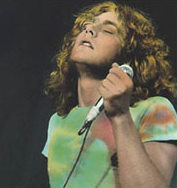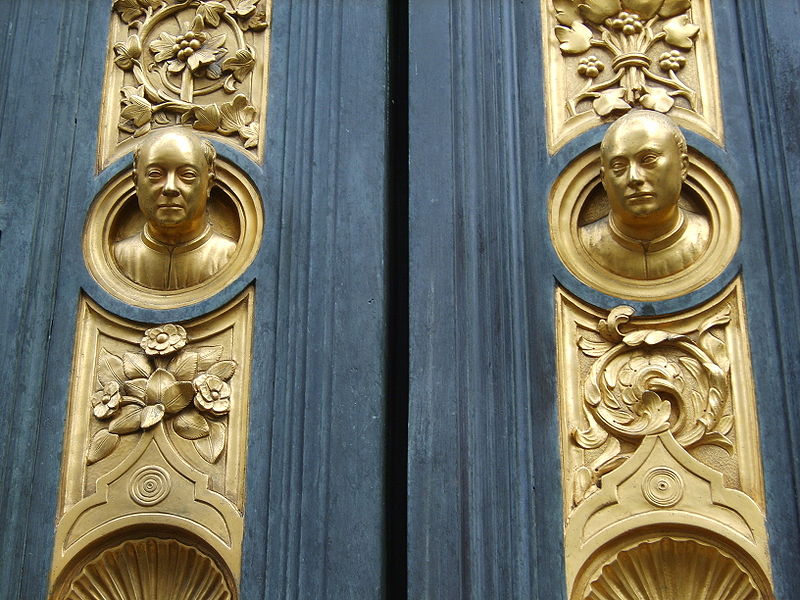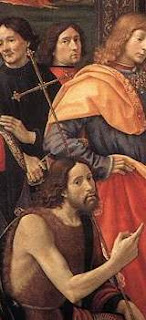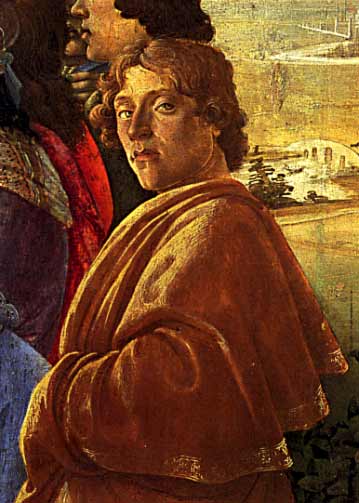Tuesday, January 25th, 2011
Wednesday, January 19th, 2011
The Ecstasy of St. Robert Plant
While commuting to work this morning, I listened to Led Zeppelin’s “Mothership” album in anticipation for my lecture on Baroque art. But there’s no similarity between those two things, you say? I beg to differ:
Saturday, January 15th, 2011
Lorenzo Ghiberti and Vittorio Ghiberti
Art historians have previously discussed how Ghiberti’s self-portrait on the “Gates of Paradise” doors (shown on the far left of the image, 1424-52, see detail image here) can be interpreted not only as a signature portrait, but also as a promotional image.1 By placing his portrait in such a prominent public location, there is little doubt that Ghiberti was interested in promoting himself as an artist. Catherine King also records that “the Latin inscription alongside [the doors] reads in translation: ‘Made with wonderful skill by Lorenzo Ghiberti.'”2
This past week, when looking at dates and details regarding the “Gates of Paradise,” I was struck with an additional idea. The “Gates of Paradise” were completed in 1452, when Ghiberti would have been about 74 or 75 years old. Therefore, at such a late point in the artist’s life, it is not surprising that Ghiberti decided to include his son Vittorio’s portrait on the door as well (see portrait on right side of the image). Vittorio inherited the family workshop after his father’s death (which was in 1455, only three short years after the “Gates of Paradise” were finished). I think that Lorenzo has anticipated his death (at least to some degree) by including his heir’s portrait. That way, even after Lorenzo died, the Ghiberti family business would still be promoted on the baptistery doors.
Smart thinking, Lorenzo.
As other historians have noted, Lorenzo was quite a “shrewd” and “keen” businessman.3 The inclusion of Vittorio’s portrait seems to be further evidence for this fact.
1 Catherine King, “Italian Artists in Search of Virtue, Fame, and Honour c. 1450-1650,” in The Changing Status of the Artist by Emma Barker, Nick Webb and Kim Woods, eds. (London: Yale University Press, 1999), 60-63.
2 Ibid.
3 Ibid., 59. See also Gary M. Radke, ed., The Gates of Paradise: Lorenzo Ghiberti’s Renaissance Masterpiece (London: Yale University Press, 2007), 67. Citation available online here.
Wednesday, January 12th, 2011
Strange and Unusual Portrait by Fontana
Yesterday I came across the strangest portrait I have ever seen. Take a look at Lavinia Fontana’s portrait of Antonietta Gonzalez (also written as “Gonzales,” c. 1595, on left). At first, I didn’t know what to make of this painting. Was it a joke? Why would young girl be depicted with a hairy face?
This is no joke, my friends. In fact, it’s a rather unusual story. Antonietta Gonzalez (as well as her father, two sisters and other family members) had hypertrichosis (also commonly called “werewolf syndrome”). This is a rare genetic disorder which causes an abnormal amount of hair on the body. (You can read more about the disorder and see some interesting images here.) Antonietta’s father, Pedro (sometimes written as Pedrus) Gonzalez, was the first known person to be affected with this disorder. Given the rarity of the disease, it seems a little surprising that so many people within the Gonzalez family were affected by hypertrichosis. One writer noted that in terms of pathology, “the Gonzales sisters were one in a billion – all three of them.”1
Luckily, though, Antonietta and her sisters were not shunned by society, but welcomed into the courts of Europe. Although I’m sure that these girls served as objects of curiosity to some degree, they also were subject to medical investigations and, obviously, portrait sittings. Antonietta explains a little of her personal history in the handwritten note which she holds in the portrait: “Don Pietro, a wild man discovered in the Canary Islands, was conveyed to his most serene highness Henry the king of France, and from there came to his Excellency the Duke of Parma. From whom [came] I, Antonietta, and now I can be found nearby at the court of the Lady Isabella Pallavicina, the honorable Marchesa of Soragna.”2
Historian Merry Weisner-Hanks has speculated that Lavinia Fontana met Antonietta in Parma. I hope to find more information about the portrait in The Marvelous Hairy Girls: The Gonzales Sisters and Their World a relatively new book by Weisner-Hanks. It looks really interesting.
Okay, so here’s my question: do you know of a portrait more unusual or strange than this one? Let’s make it a little game; I’m curious to see what people might submit. And I’ll let you, dear readers, decide what constitutes “unusual” or “strange” (e.g. the sitter, the artistic presentation of the sitter, the medium, etc.).
P.S. As I was finishing up this post, my two-year-old looked at the Fontana portrait and said, “Hey, is that you?” Ha ha! I didn’t realize that I was having such a bad hair day!
1 Jason Zasky, “Hair Apparent,” in Failure Magazine (n.d.), located here (accessed 12 January 2011).
2 Merry Weisner-Hanks, “Hairy Marvels and Beastly Sex,” in National Sexuality Resource Center (1 October 2009), located here (accessed 12 January 2011).
Sunday, January 9th, 2011
Istoria Paintings: Here’s Looking at You, Kid
I’m getting ready to teach a lecture on Alberti’s theories regarding the type of painting called istoria (also seen as historia). In his treatise On Painting (1435), Alberti argued that istoria painting is the highest goal and achievement for an artist. An istoria is a narrative painting which includes a complex composition and a large number of figures. Furthermore, these figures should be displayed in several dramatic and emotive poses. Alberti felt that “everything the people in the painting do among themselves, or perform in relation to the spectators, must fit together to represent and explain the ‘historia.'”1
One of Alberti’s most interesting ideas about istoria has to do with how the painting communicates and involves the viewer. Alberti found that an istoria painting is most effective if there is a figure in the painting who directly communicates with the viewer. He wrote, “I like there be someone in the ‘historia’ who tells the spectators what is going on, and either beckons them with his hand to look, or with ferocious expression and forbidding glance challenges them not to come near, as if he wished their business to be secret, or points to some danger or some remarkable secret, or by his gestures invites you to laugh or to weep with them.”2
I think one of the best ways for istoria figures to communicate with the viewer is through an outward glance (as if the figure was actually looking at the viewer).3 I know that there are tons of examples of such outward glances, but here is just a small sample of my favorites:
I think it’s interesting that so many painters decided to include themselves as the token “communicating figure” within their paintings. The examples by Ghirlandaio, Botticelli and Perugino are a small sampling of the staring/communicating self-portraits which exist. (To give you an idea, other such self-portraits were done by are Jacopo Pontormo (see here), Raphael (see here) and Fillipo Lippi (see here and here). But, the more that I think about it, the inclusion of the self-portrait is very fitting for historia painting, particularly when considering Alberti’s thoughts on communication. After all, if at least one figure is responsible for communicating to the viewer (and drawing the viewer into the scene), shouldn’t that figure be the artist?!? Makes sense to me.
What about you? What paintings do you enjoy where a figure is staring outwards at (or beckoning toward) the viewer? I know there are tons of them out there – especially from the Italian Renaissance period!







